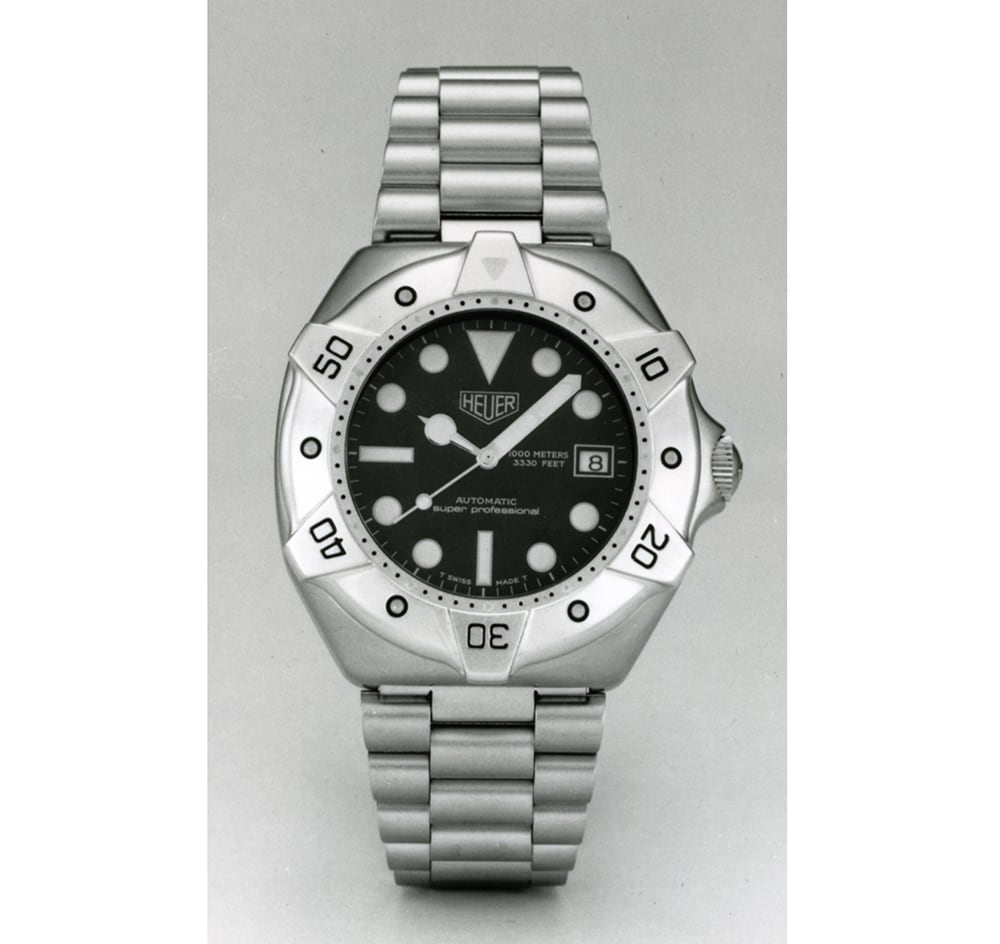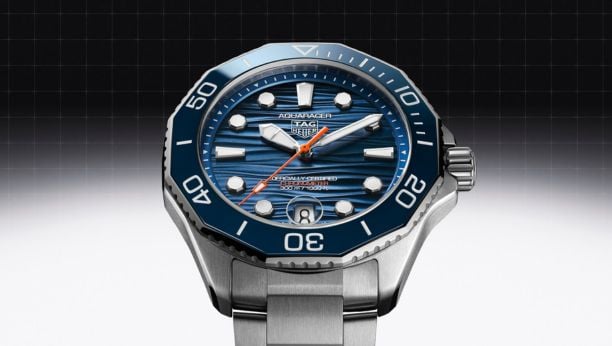VINTAGE COLLECTION
TAG HEUER SUPER PROFESSIONAL
Heuer got into the dive watch business in 1978, with the reference 844, and joined the 1000 meter depth rating club in 1982, however, all these early models followed the traditional style of dive watches from previous decades. With the Super Professional, Heuer demonstrated that it could move from the traditional style dive watch to a model that was purpose-built for professionals. The monobloc case, with its very prominent bezel, was unlike any dive watch previously made by Heuer, or for that matter any other company in the watch industry. Heuer achieved great success in stepping out from the traditional geometry of the dive watch, building a range of models that would be in its catalog for almost 20 years.
In the world of dive watches, there is something of a club comprised of the brands that offer watches with 1,000 meters of water resistance. Of course, the average dive watch enthusiast is unlikely to ever visit anywhere near that depth, but like the sports car capable of reaching 300 kilometers per hour, there is tremendous satisfaction in the engineering and construction that allow a watch to operate at this depth. As a brand, you are either in the 1000 meter dive watch club, or you’re not.
Heuer produced its first series of dive watches in 1978, with the legendary reference 844 model (featuring a 200 meter depth rating), and in 1982 Heuer joined the 1000 meter club, with the reference 980.023, which collectors call the “Deep Dive”. Looking at the watches from the 1960s and 1970s that have the 1000 depth rating, we see two basic styles of construction. The first 1000 meter dive watches from the 1960s used thick monobloc cases, which have a solid back and provide access to the movement by removing the crystal. An alternative approach is to follow the basic geometry of a more conventional dive watch, with the case being thicker to house the seals required for the enhanced waterproofing. In producing the Deep Dive watch, Heuer took this later approach, using a conventional style case similar to the reference 844 model, made thicker to achieve the 1000 depth rating.
With Heuer’s first dive watches following the shape of traditional dive watches dating back to the 1950s, and its first Deep Dive watch using the same basic style, in 1984, Heuer would take a new approach, joining the monobloc branch of the 1000 meter club. The new watch, called the “Super Professional” (reference 840.006), had a look that was different from any dive watch previously made by Heuer, or perhaps from any dive watch made by any company. That’s how different the Super Professional looked, from every angle.
The Super Professional would enjoy a long stay in the Heuer and TAG Heuer catalogs, being launched with “Heuer” on the dial, and soon carrying the “TAG Heuer” logo, and continuing into the early years of the 21st century. Indeed, the Super Professional was introduced when Heuer was owned by Nouvelle Lemania and Piaget, achieved strong sales in the TAG Heuer catalogue, and would be part of the company that was purchased by LVMH in 1999.
THE HEUER SUPER PROFESSIONAL
The Super Professional first appeared in the 1984 Heuer catalog as a replacement for the 1000 meter diver (“Deep Dive”), even though that watch continued in the TAG Heuer catalog for a few more years. The Super Professional was available in two models -- the more common model with a stainless steel bead-blasted case and a second version with a gold-colored bezel. The watch was powered by the ETA 2892 automatic movement.
The bracelet for the Super Professional matched the matte finish of the case. The watch was also available with a dive kit, which included two spare straps, a strap-changing tool and a decompression table. These dive kits came either in the blue pouch or in the more common black pouch.

DESIGN
The dial and hands of the Super Professional followed a traditional style – a triangle at 12 o’clock, date at 3 o’clock, dashes at 6 o’clock and 9 o’clock, and dots to mark all remaining hours. All these elements are considerably larger than on Heuer previous dive watches, consistent with the exaggerated size of the Super Professional’s case. The hour and minute hands were a new style for Heuer, being wider than on the previous models.
One of the interesting features of the Super Professional is that the watch featured a solid, one-piece case without a removable case-back, to ensure that the watch operated reliably at depths. To access the movement, first the bezel has to be removed and then the inner ring and crystal to get at the movement and dial.
The most prominent feature of the Super Professional was the oversized grips on the bezel, each a raised trapezoid, marked to show 10-minute increments. The Super Professional measured almost 43 millimeters across the bezel, with a thickness of 14 millimeters.
TAG HEUER SUPER PROFESSIONAL
The Super Professional stayed in the TAG Heuer catalog until the early 2000s, during which time TAG Heuer changed the case design, making it slightly larger (43mm) and more square, as well as changing the reference number to fit within the standard TAG Heuer numbering system (WS2110).
THE BLACK-COATED SUPER PROFESSIONAL
The rarest of the Super Professional watches is the black-coated Super Professional -- essentially a “Full Black” version of the standard stainless steel watch.
There are actually two versions of the black-coated Super Professional -- the production version reference 843.006 and the earlier prototype version created in 1989 as a limited run of 500 watches in partnership with the American company, Security Defense Systems. While the first prototypes carry the reference number 840.006, documentation shows that TAG Heuer intended for the production model to have the reference code 850.006.







